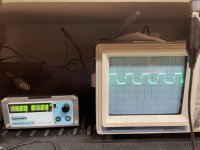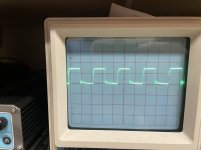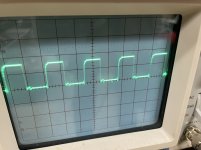Here I have this Lanzar Optidrive 2500, which blew its PS. Was using IRFZ44 with 100ohm gates. A bunch of PS drivers items fried. Board is using 4401/4403 for drivers.
Reference thread: https://www.diyaudio.com/forums/car-audio/281020-lanzar-optidrive-2500-a.html
All pre-drivers Q60-Q64 need to be replaced. The board also burned as well. Will be using the link as reference for re-conditioning.
I am unable to get a solid 'lock' on the SG3525 pins 11/14 with my scope. Usually this is never an issue but for this amp its just creating solid 'bars' on the scope at 0vDC and ~7vDC with information between which I cannot lock onto. Usually I can see outputs of this and similar PWM ICs no problem.
I suspect the SG may be hurt on account of all the pre-drivers shorted/blown/etc.
Does this SG3525 look OK?
SG3525
1: 0.995
2: 1.089
3: 0.024
4: 0.197
5: 2.054
6: 3.839
7: 2.054
8: 4.93
9: 5.32
10: 0.025
11: 3.676
12: 0.004
13: 8.42
14: 3.663
15: 14.14
16: 5.19
Reference thread: https://www.diyaudio.com/forums/car-audio/281020-lanzar-optidrive-2500-a.html
All pre-drivers Q60-Q64 need to be replaced. The board also burned as well. Will be using the link as reference for re-conditioning.
I am unable to get a solid 'lock' on the SG3525 pins 11/14 with my scope. Usually this is never an issue but for this amp its just creating solid 'bars' on the scope at 0vDC and ~7vDC with information between which I cannot lock onto. Usually I can see outputs of this and similar PWM ICs no problem.
I suspect the SG may be hurt on account of all the pre-drivers shorted/blown/etc.
Does this SG3525 look OK?
SG3525
1: 0.995
2: 1.089
3: 0.024
4: 0.197
5: 2.054
6: 3.839
7: 2.054
8: 4.93
9: 5.32
10: 0.025
11: 3.676
12: 0.004
13: 8.42
14: 3.663
15: 14.14
16: 5.19
It was a trigger issue on my scope.
Moving on, I replaced the PS drivers with the following:
Position: Original --> Replacement
Q60: 4403 --> BD140
Q61: 4401 --> BD139
Q62: 4403 --> BD140
Q63: 4403 --> BD140
Q64: 4401 --> BD139
Q86: 4403 -->BD140
I made sure I twisted/flipped ALL base and collectors of the BDs as they're opposite compared to the 440x.
I powered and tested with scope connected to the emitter pairs per side and revealed a clean square wave.
Then I went ahead and put 4x IRF3205 with 47ohm (Also tried 22 ohm) gate resistors. I pulled the two large rectifiers out of circuit for now.
The PS FETs are getting warm and the waveform on their gates doesn't look so great. Current draw is 1.3 amps.
Moving on, I replaced the PS drivers with the following:
Position: Original --> Replacement
Q60: 4403 --> BD140
Q61: 4401 --> BD139
Q62: 4403 --> BD140
Q63: 4403 --> BD140
Q64: 4401 --> BD139
Q86: 4403 -->BD140
I made sure I twisted/flipped ALL base and collectors of the BDs as they're opposite compared to the 440x.
I powered and tested with scope connected to the emitter pairs per side and revealed a clean square wave.
Then I went ahead and put 4x IRF3205 with 47ohm (Also tried 22 ohm) gate resistors. I pulled the two large rectifiers out of circuit for now.
The PS FETs are getting warm and the waveform on their gates doesn't look so great. Current draw is 1.3 amps.
Attachments
Was the trace aligned to the reference line before probing the gates?
Vertical amplifier and timebase settings?
Vertical amplifier and timebase settings?
Yes. The troughs are up about 1v from -B which is where scope is referencing.
5vDiv and 5uS on the scope.
5vDiv and 5uS on the scope.
Last edited:
Temporarily connect a 330 ohm resistor (or anything close) between the collector and emitter of each of the BD140 drivers.
Does that help?
Does that help?
That didn’t change much with a 470ohm temporary resistor. Fets still get too warm after about 10 seconds.
I also tried jumping a lead over the 47ohm driver gate resistors between the SG and the base of the BDs. That actually helped some but the fets still get warm after about 30 seconds.
Let me post a clearer photo of the signal at the gates now.
Still,
Rectifiers out of circuit
Jumped 47ohm gates
470o temporary between E&C
I also tried jumping a lead over the 47ohm driver gate resistors between the SG and the base of the BDs. That actually helped some but the fets still get warm after about 30 seconds.
Let me post a clearer photo of the signal at the gates now.
Still,
Rectifiers out of circuit
Jumped 47ohm gates
470o temporary between E&C
Do you have a multimeter that reads frequency?
One thing that may be happening is that you have no rectifiers in the circuit and if this supply is regulated, the pulse width may be a point where it will rarely be in normal operation.
Why are the rectifiers out?
One thing that may be happening is that you have no rectifiers in the circuit and if this supply is regulated, the pulse width may be a point where it will rarely be in normal operation.
Why are the rectifiers out?
They’re out because I was being cautious with having the precision install the bd drivers.
I went ahead and put them back in. Seems to be running fine and cool now, except Q41, Q42, Q15 and Q16 are getting warm. Probably fine though. I’ll put this one back together with minimal resistor modifications.
I went ahead and put them back in. Seems to be running fine and cool now, except Q41, Q42, Q15 and Q16 are getting warm. Probably fine though. I’ll put this one back together with minimal resistor modifications.
This supply uses no deadtime resistor so deadtime is as low as possible. This isn't a problem but when running at the maximum duty cycle, it shows up in FET heating. When the rectifiers are int he circuit, the rails feedback to the 3525 and force it to reduce the duty cycle. Even the slightest reduction in duty cycle eliminates the heating.
One problem with the drive on this amp is the abnormally high operating frequency. That alone can make slight changes in the drive.
One problem with the drive on this amp is the abnormally high operating frequency. That alone can make slight changes in the drive.
Thank you. This amp is back together and ready for some high amperage testing tomorrow.
I do have a frequency meter. Its a Klein CL390 AC/DC amperage clamp from HomeDepot. It does a few more things than my Fluke 16, but I HATE it. It beeps constantly, shuts off in 5 minutes, does warnings etc. Even when ohming things out the darn thing never shuts up! I was going to put a 20kOhm resistor on it's speaker or something. I only use if for the amperage clamp, and bias adjustment since it has an extra digit over my Fluke 16. But even then the dang thing beeps after 5 minutes and then shuts off. I have to mess with too many buttons to get it to cooperate.
I do have a frequency meter. Its a Klein CL390 AC/DC amperage clamp from HomeDepot. It does a few more things than my Fluke 16, but I HATE it. It beeps constantly, shuts off in 5 minutes, does warnings etc. Even when ohming things out the darn thing never shuts up! I was going to put a 20kOhm resistor on it's speaker or something. I only use if for the amperage clamp, and bias adjustment since it has an extra digit over my Fluke 16. But even then the dang thing beeps after 5 minutes and then shuts off. I have to mess with too many buttons to get it to cooperate.
It's hard to beat a Fluke meter. I loved the 10, 11 and 12 and they were virtually the only meter I ever had on the bench. On occasion when I needed other features, I had an 87V and an old HP 4-wire for ultra-high resolution.
There's no reason to measure the frequency now that everything is OK.
There's no reason to measure the frequency now that everything is OK.
I wish my Fluke 10 still worked. It has a real hard time cycling through the SELECT and RANGE functions. The board uses soft contacts and I guess its just flat worn out. I may try some DeoxIt next time I take it apart.
I've had that Fluke 10 meter since I was 10 years old and I'm now 41. I will probably give it to my 5-year old son, if I get around to fixing it.
I've had that Fluke 10 meter since I was 10 years old and I'm now 41. I will probably give it to my 5-year old son, if I get around to fixing it.
- Home
- General Interest
- Car Audio
- Lanzar Optidrive 2500


